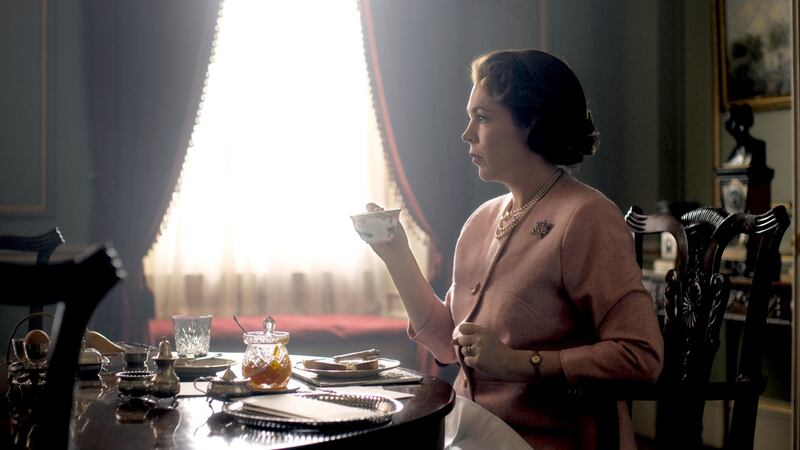The Crown is back on Netflix. The first two series covered our hero's rise from a plucky underdog engaged in backstreet underground Queening contests to the pinnacle of the professional cutthroat Queening racket, with the help of her gruff no-nonsense coach, Winston Churchill ("If you wanna be a winnah ya gotta learn howta fight doity!" as he said in Season 1).
Now, at the start of series three she's in the big leagues, the top Queen of all of England. She's even changed her name from Toots Callaghan to Queen Elizabeth II. Who can challenge her title now? Nobody, that's who!
This may not resemble the actual plot of the first two series of The Crown. I might have changed a few details to add drama and suspense to a subject so otherwise predictable it’s a literal tradition.
I feel the need to keep saying 'spoiler alert' even though I know people should be aware that Churchill wasn't immortal and that nobody abolished the monarchy
Season three begins in with the back of the Queen’s head, which, like the front of her head, is now played by Olivia Colman and is consequently quite expressive. She is wearing a crown, possibly “The Crown” of the title but maybe just a crown-shaped hat that she has for casual wear. She is also looking at two massive postage stamps. These postage stamps are far too big, but she is the Queen and she can do what she likes.
(Offscreen: “But these enormous stamps will overwhelm the whole envelope!” cries a servant boy.
“I do as I please,” says the Queen. “Now, build me a massive novelty post box”).
The Queen evaluates the two massive postage stamps. One of them has her old head on it (aka Claire Foy’s head). The other her new head (aka Olivia Colman’s head). Yes, Queens can change their heads like Doctor Who or Worzel Gummidge.
“They’re almost identical,” says a lackey. “The slightest changes in the hair.”
This is what, in the show business, is known as a meta reference. It’s an inside joke for people who notice things like casting changes and one actor being physically different from another actor. Luckily, Olivia Colman stops herself from winking at the camera, because she is a pro and, also, queens can’t wink.
There are new challenges for the Queen. The World is Changing, something which is ever surprising to people in period dramas, but which is taken as a wearisome inevitability for those of us in “real life” as we sign up to TikTok and shout at children on the bus.
In this case there's an election on and it looks like that upstart Harold Wilson is going to be prime minister. "We must face the cold wind of socialism blowing through this land once more," says Winston Churchill from his deathbed, malingering and "fit for work" by the standards of his Tory successors.

The Queen is moved by the rise of socialism and her sick friend. “You were my guardian angel, the roof over my head, the spine in my back, the iron in my heart, the compass that steered and directed me,” she says because she is the Queen and can afford to put as many metaphors as she likes into one sentence. It’s probably treason to say, “Seriously, Liz, pick one and stick to it”.
Spoiler alert: Harold Wilson gets in.
Spoiler alert: There are rumours Harold Wilson is a Russian spy who might abolish the monarchy.
Spoiler alert: He isn’t and he doesn’t.
Spoiler alert: He and the Queen come to a sort of “we’re not so different you and I” understanding.
Spoiler alert: Who is this significant guardian of the Queen's portraits? Why it's Anthony Blunt, the fourth man in the Cambridge spy ring, uncovered but unpunished by the end of the episode.
Spoiler alert: The Queen is quite icy with Anthony Blunt as a consequence.
Spoiler alert: Winston Churchill dies.
<a class="search" href='javascript:window.parent.actionEventData({$contentId:"7.1213540", $action:"view", $target:"work"})' polopoly:contentid="7.1213540" polopoly:searchtag="tag_person">Helena Bonham</a> Carter as <a class="search" href='javascript:window.parent.actionEventData({$contentId:"7.1213540", $action:"view", $target:"work"})' polopoly:contentid="7.1213540" polopoly:searchtag="tag_person">Princess Margaret</a> is pretty great too. Her dilemma is how difficult it is to be the fantastically wealthy and unpleasant sister of a Queen
That's just episode one. I feel the need to keep saying "spoiler alert" even though I know people should be aware that Churchill wasn't immortal and that nobody abolished the monarchy and that Harold Wilson was prime minister.
Who knows what people know nowadays? If Brexit has taught us anything it's that the British have little conception of their own history beyond a handful of overly-fetishised events they've crayoned Union Jacks on top of.
This series goes from 1964 to 1977 and it does delve into the thickets of the Aberfan mining disaster but the Troubles don’t get a look in. And I just checked on Wikipedia – that really happened.
Instead, we get long, lingering shots of vintage cars and stately rooms so beautifully framed and servants and stunt Corgis so beautifully choreographed that you almost forget that they’re there to pad out the story. At one point the Queen even dresses in slow motion (more accurately she is dressed by servants like she is a baby, a royal baby). This is The Crown’s version of a car chase.
The Crown should look good. It cost around 100 million slowly devaluing British pounds to make. You could sporadically have the writer Peter Morgan run screaming past the cameras clutching fistfuls of burning cash and it wouldn't look more expensive.
But this programme is ultimately about a rich family who stay picturesquely still as the world moves around them. Being royals is like a game of statues. Having Olivia Colman in it helps. She’s very good at reacting to things in a subtle fashion, which is largely all the Queen has to do.
Helena Bonham Carter as Princess Margaret is pretty great too. Her dilemma is how difficult it is to be the fantastically wealthy and unpleasant sister of a Queen dispatched to meet Lyndon Johnson for diplomatic reasons. Helena Bonham Carter is so good she almost makes that sentence relatable.
I found myself almost resenting my brother the King, until I remembered that he wasn’t the King and that it was me, not him, who is our parents’ favourite son (Sorry to tell you like this, Dave).
Lasering people to death

Elsewhere there was more period drama to consume. On Sunday night HG Wells's The War of the Worlds (BBC1) reminds us of that time in the late Victorian age when the plucky Brits fought the Martian hordes and saved Europe.
Seriously, unless they put a disclaimer at the start (“NOT ACTUAL HISTORY”), this is going to turn up in one of Boris’s stump speeches. Setting the story in the time period when Wells wrote it is a nice touch but pacing it the same way is a bit of a mistake.
We know there’s a robot Martian tripod beneath that pulsating CGI asteroid. It isn’t a surprise when it emerges and starts lasering people to death towards the end of the episode.
The olden days Queen would know what to do, of course. She’d give the death robot a suitably withering look. Contemporary Brits, on the other hand, would vote for it. “Yes, the death robot is lasering us to death but Corbyn’s a socialist!”
To take my mind off the British election I watch Cat Hospital (RTE1, Friday). My suspicions are confirmed. Cats make terrible doctors. If the HSE don't stop this crazy experiment I fear people will die.
















